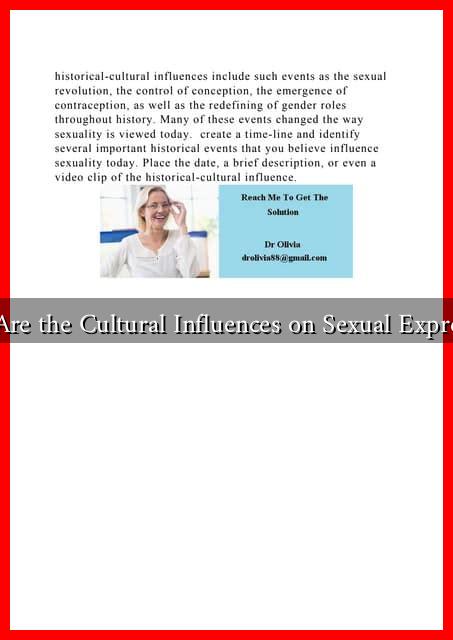-
Table of Contents
What Are the Cultural Influences on Sexual Expression?
Sexual expression is a complex interplay of biological, psychological, and cultural factors. While biological imperatives drive human sexuality, cultural influences shape how individuals express their sexual identities, desires, and behaviors. This article explores the various cultural influences on sexual expression, examining how societal norms, religion, media, and education contribute to the diverse ways in which sexuality is experienced and expressed across different cultures.
The Role of Societal Norms
Societal norms play a crucial role in shaping sexual expression. These norms dictate what is considered acceptable or taboo in a given culture, influencing individual behaviors and attitudes towards sex. Some key aspects include:
- Gender Roles: Many cultures have specific expectations regarding masculinity and femininity, which can dictate sexual behavior. For instance, in some societies, men are expected to be dominant and sexually assertive, while women may be encouraged to be passive and modest.
- Sexual Orientation: Acceptance of different sexual orientations varies widely. In cultures with rigid heteronormative standards, LGBTQ+ individuals may face discrimination, leading to a more subdued expression of their sexuality.
- Age and Sexuality: Cultural attitudes towards age can also influence sexual expression. In some cultures, older individuals may be viewed as less sexually active, while in others, they are celebrated for their experience and wisdom.
Religious Influences on Sexual Expression
Religion is another powerful force that shapes sexual expression. Different religious beliefs can impose strict guidelines on sexual behavior, often promoting abstinence or specific sexual practices. For example:
- Christianity: Many Christian denominations advocate for premarital abstinence and view sex primarily as a means of procreation within marriage.
- Islam: Islamic teachings emphasize modesty and chastity, with strict guidelines on sexual conduct, particularly for women.
- Buddhism: While generally more permissive, some Buddhist traditions advocate for celibacy among monks and view sexual desire as a potential source of suffering.
These religious teachings can significantly impact individuals’ sexual behaviors and attitudes, often leading to internal conflicts for those who feel their desires clash with their beliefs.
The Impact of Media and Technology
In the modern world, media and technology have transformed how sexual expression is perceived and enacted. The rise of the internet and social media has created new platforms for sexual expression, but it has also introduced challenges:
- Access to Information: The internet provides access to a wealth of information about sexuality, allowing individuals to explore diverse sexual identities and practices. However, misinformation can also proliferate.
- Portrayal of Sexuality: Media representations of sex can shape societal attitudes. For instance, the prevalence of hypersexualized images in advertising and entertainment can create unrealistic expectations about sexual performance and desirability.
- Online Communities: Social media platforms have enabled marginalized groups to find community and support, fostering greater acceptance of diverse sexual expressions.
The Role of Education
Sexual education is a critical factor in shaping sexual expression. Comprehensive sexual education programs can empower individuals with knowledge about their bodies, consent, and healthy relationships. Key points include:
- Access to Education: In cultures where sexual education is lacking or stigmatized, individuals may grow up with misconceptions about sex, leading to unhealthy sexual behaviors.
- Inclusivity: Programs that include discussions about diverse sexual orientations and identities can foster acceptance and understanding, allowing individuals to express their sexuality more freely.
- Consent and Communication: Education that emphasizes the importance of consent and communication can lead to healthier sexual relationships.
Conclusion
Cultural influences on sexual expression are multifaceted and deeply embedded in societal norms, religious beliefs, media portrayals, and educational practices. Understanding these influences is essential for fostering a more inclusive and accepting environment for diverse sexual expressions. As societies evolve, so too do the norms and values surrounding sexuality, highlighting the importance of ongoing dialogue and education in promoting healthy sexual expression.
In summary, the interplay of culture and sexuality is complex, and recognizing the various factors at play can help individuals navigate their own sexual identities and expressions more effectively. For further reading on this topic, consider exploring resources from organizations like Planned Parenthood or Human Rights Campaign.

